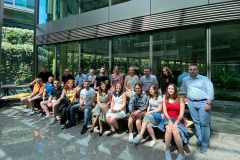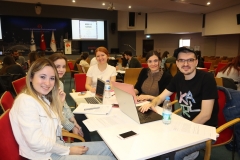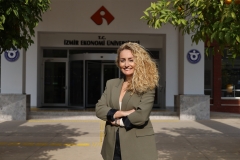
FACULTY OF COMMUNICATION
Department of Public Relations and Advertising
PRA 314 | Course Introduction and Application Information
| Course Name |
Marketing Communication Metrics
|
|
Code
|
Semester
|
Theory
(hour/week) |
Application/Lab
(hour/week) |
Local Credits
|
ECTS
|
|
PRA 314
|
Spring
|
3
|
0
|
3
|
6
|
| Prerequisites |
None
|
|||||
| Course Language |
English
|
|||||
| Course Type |
Required
|
|||||
| Course Level |
First Cycle
|
|||||
| Mode of Delivery | Blended | |||||
| Teaching Methods and Techniques of the Course | DiscussionGroup WorkQ&ACritical feedbackApplication: Experiment / Laboratory / WorkshopLecture / Presentation | |||||
| Course Coordinator | - | |||||
| Course Lecturer(s) | ||||||
| Assistant(s) | - | |||||
| Course Objectives | This course aims to provide students knowledge and perspective regarding integrated marketing communication campaign metrics and how these metrics can be beneficial for communication specialists before, during and after a campaign. |
| Learning Outcomes |
The students who succeeded in this course;
|
| Course Description | In this course, students will be introduced to key campaign metrics in the offline and digital communications domain. Embracing data-driven communication efforts, the course will enable students to interact with current digital analytics tools via real-life examples. Students will gain hands-on experience of using campaign analytics while preparing the campaign as well as managing and assessing the process. |
|
|
Core Courses |
X
|
| Major Area Courses | ||
| Supportive Courses | ||
| Media and Management Skills Courses | ||
| Transferable Skill Courses |
WEEKLY SUBJECTS AND RELATED PREPARATION STUDIES
| Week | Subjects | Related Preparation |
| 1 | Introduction to the course | |
| 2 | Why do we need to measure? Intelligence in planning, SMART goals, accountability, transparency, | Farris et al. (2006) Chapter 1 Jeffery et.al (2010) Chapter 1-2 |
| 3 | Fundamental Trends Shaping Marketing | Kotler et al (2021) Chapter 1-2-4 |
| 4 | Fundamental KPIs I: Brand awareness, Market Share, Household Penetration, Repeat Purchase Rate, Brand Loyalty and other Usage, Image and Attitude Indicators II: Price positioning, Budgeting for marketing, Financial return on marketing investment, customer lifetime value Blog Training | Farris et al. (2006) Chapter 2-3-10 Jeffery et.al (2010) Chapter 3-4-5-6 |
| 5 | According to what and how are website key performance indicators determined? How to start measuring with which technical infrastructures? | |
| 6 | SEO Marketing and Social Media Marketing Practices | |
| 7 | Digital metrics panels and performance indicators on panels, decision making techniques for optimization in digital marketing | |
| 8 | Midterm | |
| 9 | Best practices for improving performance by industry (Google + YouTube) | |
| 10 | Optimization and measurement in Meta and TikTok Data-driven insights and solutions that increase return on ad spend (ROAS) and customer lifetime value (CLV) | |
| 11 | Artificial Intelligence Assisted Measurement | |
| 12 | Essential Metrics for the Simulation Quiz | In-class exercise |
| 13 | Simulation | In-class exercise |
| 14 | Project Presentations | |
| 15 | Semester Review | |
| 16 | Semester Review |
| Course Notes/Textbooks | ||
| Suggested Readings/Materials |
|
EVALUATION SYSTEM
| Semester Activities | Number | Weigthing |
| Participation |
1
|
5
|
| Laboratory / Application | ||
| Field Work | ||
| Quizzes / Studio Critiques |
1
|
5
|
| Portfolio | ||
| Homework / Assignments |
1
|
20
|
| Presentation / Jury |
1
|
10
|
| Project |
1
|
20
|
| Seminar / Workshop | ||
| Oral Exams |
1
|
20
|
| Midterm |
1
|
20
|
| Final Exam | ||
| Total |
| Weighting of Semester Activities on the Final Grade |
7
|
100
|
| Weighting of End-of-Semester Activities on the Final Grade | ||
| Total |
ECTS / WORKLOAD TABLE
| Semester Activities | Number | Duration (Hours) | Workload |
|---|---|---|---|
| Theoretical Course Hours (Including exam week: 16 x total hours) |
16
|
3
|
48
|
| Laboratory / Application Hours (Including exam week: '.16.' x total hours) |
16
|
0
|
|
| Study Hours Out of Class |
14
|
2
|
28
|
| Field Work |
0
|
||
| Quizzes / Studio Critiques |
1
|
4
|
4
|
| Portfolio |
0
|
||
| Homework / Assignments |
1
|
20
|
20
|
| Presentation / Jury |
1
|
20
|
20
|
| Project |
1
|
20
|
20
|
| Seminar / Workshop |
0
|
||
| Oral Exam |
1
|
15
|
15
|
| Midterms |
1
|
25
|
25
|
| Final Exam |
0
|
||
| Total |
180
|
COURSE LEARNING OUTCOMES AND PROGRAM QUALIFICATIONS RELATIONSHIP
|
#
|
Program Competencies/Outcomes |
* Contribution Level
|
||||
|
1
|
2
|
3
|
4
|
5
|
||
| 1 | To be able to critically interpret theories, concepts, methods, instruments and ideas that form the basis of Public Relations and Advertising field. |
|||||
| 2 | To be able to collect and use necessary data to produce content in the field of Public Relations and Advertising with scientific methods. |
X | ||||
| 3 | To be able to use theoretical knowledge gained in the field of Public Relations and Advertising in practice. |
X | ||||
| 4 | To be able to use analytical thinking skills in the field of Public Relations and Advertising. |
X | ||||
| 5 | To be able to convey creative ideas and solution suggestions supported by scientific data in written and oral form to stakeholders. |
X | ||||
| 6 | To be able to take responsibility as individual and group members to solve problems encountered in the practice of Public Relations and Advertising field. |
X | ||||
| 7 | To be able to develop solutions that favor public good and raise awareness by having knowledge about regional, national and global issues and problems. |
|||||
| 8 | To be able to relate the basic knowledge of other disciplines supporting the field of Public Relations and Advertising with his/her own field of expertise. |
X | ||||
| 9 | To be able to use the knowledge, skills and competencies acquired by following regulations, innovations, changes, current developments, and occupational health and safety practices closely in the field of Public Relations and Advertising; in a lifelong manner and for individual and social purposes. |
|||||
| 10 | To be able to collect, interpret and share data by considering social, scientific and professional ethical values in the field of Public Relations and Advertising. |
|||||
| 11 | To be able to collect data in the areas of Public Relations and Advertising and communicate with colleagues in a foreign language ("European Language Portfolio Global Scale", Level B1) |
|||||
| 12 | To be able to speak a second foreign at a medium level of fluency efficiently. |
|||||
| 13 | To be able to relate the knowledge accumulated throughout the human history to their field of expertise. |
|||||
*1 Lowest, 2 Low, 3 Average, 4 High, 5 Highest
NEWS |ALL NEWS

1.3 million support from TUBITAK for the exemplary project
4 academics from Izmir University of Economics (IUE) took action on the increase in natural disasters such as floods, fires, tornadoes and

7 industrial visits in 3 days
Izmir University of Economics (IUE) Department of Public Relations and Advertising organized an industrial visit to Istanbul for its students to offer

‘Kindness in Communication’ ideas by IUE students
Students of Department of Public Relations and Advertising, Izmir University of Economics (IUE) developed creative ideas for a world-famous tire brand (Continental)

‘Kindness in Communication’ ideas by IUE students
Students of Department of Public Relations and Advertising, Izmir University of Economics (IUE) developed creative ideas for a world-famous tire brand (Continental)

Our department, which was accredited by the Communication Research Association (ILAD) in 2020, successfully completed the interim evaluation process and was entitled to a total of five years of accreditation.
ILAD, the national quality assurance institution authorized by the Higher Education Quality Board (YÖKAK) for communication education, accredited our Public Relations and

IUE graduate academic at a world-renowned university
Lena Çavuşoğlu, a graduate of Izmir University of Economics (IUE), pursued her dreams about having an academic career abroad instead of working

'International' cooperation of Izmir University of Economics
Izmir University of Economics (IUE) Department of Public Relations and Advertising took another important step towards internationalization and collaborated with the famous

